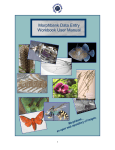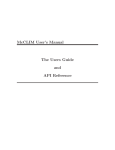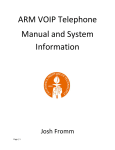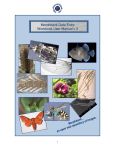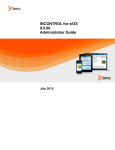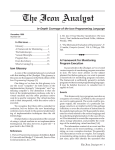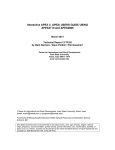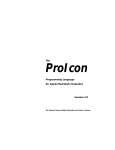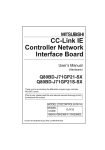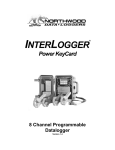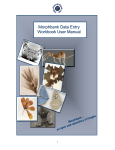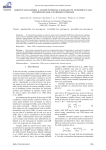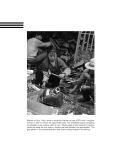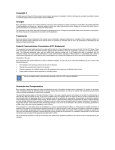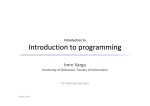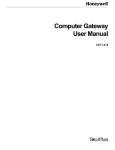Download Icon Analyst 50 - Department of Computer Science
Transcript
The Icon Analyst
In-Depth Coverage of the Icon Programming Language
October 1998
Number 50
In this issue …
About This Issue ................................ 1
Analyzing Character Patterns .......... 1
Versum Deltas .................................... 7
Graphics Corner ............................... 10
Tricky Business ................................ 14
From the Library .............................. 19
What’s Coming Up .......................... 20
About This Issue
We have a lot of material backed up, and some
of it, as you will see in this issue of the Analyst,
covers a lot of real estate.
Rather than have things stack up further or
sacrifice content, we’ve gone to a 20-page issue.
(Because of the way the Analyst is bound, the page
count has to be a multiple of four.)
We do not expect to produce this many pages
on a regular basis. In fact, all we promise is 12
pages, although recently, most have been 16.
Analyzing Character Patterns
The distinguishing characteristic of a string is that
it is one of the most compact ways of storing vast
amounts of data in a way in which information can
be replicated. —Michio Kaku [1]
In two previous articles on character patterns
[2-3], we explained how character patterns can be
useful in representing sequences of values, and we
used pattern forms and grammars to identify the
structure of sequences.
This article describes an application that helps
in analyzing character patterns — finding pattern
forms and building pattern grammars.
Overview
The application is named charpatt. Any similarity between the pronunciations of charpatt and
carpet can be attributed to space aliens.
The application supports importing character strings, identifying pattern forms, and building
Back Issues
Back issues of The Icon Analyst are available for $5 each. This price includes shipping in the United States, Canada, and
Mexico. Add $2 per order for airmail postage to other countries.
The Icon Analyst 50 / 1
grammars. The interface is shown in Figure 1 with
a partially developed grammar.
At the top are menus and below them information panels.
The scrolling text list at the left is a workspace
that shows one of the definitions in the current
grammar. The workspace allows the detailed examination of a definition and can be used to identify a specific substring. It also is the place where
most searches for pattern forms are made.
The scrolling text list at the right shows the
grammar. Clicking on a definition places the definition in the workspace.
The information panels give the name of the
grammar file, its size in bytes, the variable associated with the current definition, the number of
symbols remaining that can serve as variables, and
finally the depth of the grammar, which is the
number of L-System generations necessary to produce the character pattern.
The menus provide the following services:
• Grammar: operations related to the grammar
as a whole.
• Tokens: operations related to the values associated with the labeling characters in character patterns.
• Options: configuration settings.
Loading and Saving Data
The File menu provides facilities related to
bringing in data and saving it. Rather than occupy
space with an image of each menu, we’ll explain
instead in terms of the keyboard shortcuts for
menu items.
@O: Open a previously saved grammar.
@S: Save the current grammar.
@C: Load a character pattern to create a new
grammar.
@V: Create a character pattern and a new
grammar from a sequence of values.
• File: opening and saving grammars, importing character strings, and other file-related
activities.
@E: Create a grammar by entering a character
pattern manually.
• Search: looking for various pattern forms
and related operations.
@U: Undo last change to the current grammar.
• Workspace: operations related to the current
definition.
@T: Redo the last undo.
@A: Revert to last saved grammar.
Figure 1. The charpatt Interface
2 / The Icon Analyst 50
For @O, @C, and @V, the navigation interface described in Reference 4 is used.
Grammars are saved as L-Systems so that
they can be expanded by existing programs.
For @C, the character pattern is taken from a
specified range of lines in a file. For @V, values can
be imported in two ways: as one value per line of
a file or lines with blank-separated values. (At
present, values can only be strings or values that
can be represented by strings, which includes numbers.)
For @E, a text-entry dialog is presented for
typing a character pattern. Only short grammars
can be created in this way; it’s mainly useful for
testing.
Searching for Pattern Forms
The string to be searched for is entered in the
first text-entry field. The range specification, in the
style of Icon character-position numbering, applies to the workspace and allows the search to be
restricted to a portion of it. In Figure 2, the entire
workspace is specified.
The decollation field provides for the result to
be decollated into a number of fields [3]. The default is 1, specifying no decollation (the usual setting).
The final text-entry field limits results to those
that produce at least the specified reduction in the
size of the grammar — 10 characters in this case.
(The savings can be negative to allow pattern forms
that increase the size of the grammar.)
Figure 3 shows the result for the grammar
shown in Figure 1.
The Search menu provides several ways of
searching for pattern forms:
@F: Find a specific substring.
@K: Find a substring by range.
@P: Find palindromes.
@R: Find repetitions by length.
@H: Find repetitions of a specific string.
@N: Find n-grams.
@L:
Find locations at which a string occurs.
Except for @N, which processes all definitions, all searches take place in the workspace.
Except for @L, which provides information
that may be useful in other searches, all successful
searches produce pattern forms for the strings that
are found. These then can be used to create new
definitions in the grammar and replace instances
of the strings by the variables for the new definitions.
The simplest kind of search is for a specific
string. Figure 2 shows a typical dialog for @F.
Figure 3. Results of a Search
If the result is accepted, a new definition is
created and all occurrences of the string are replaced by the new variable.
Searching for repetitions by length provides
an example of a more complicated kind of search.
Figure 4 shows the dialog box for @R.
Figure 4. Dialog for @R
Figure 2. Dialog for @F
The first two text-entry fields specify limits
for the number of characters in a repetition — that
is, ∗s in [s,i]. In Figure 4, s can range from 5 to 9
characters.
The Icon Analyst 50 / 3
The next two text-entry fields specify the
minimum number of repetitions (i) and the minimum number of times the repetition occurs in the
grammar. Although the search is based on the
workspace, once a repetition is found, all other
definitions are searched for instances of it.
The dialog as shown in Figure 4 limits the
number of results to 10, while the limit on the
attempts to find repetitions is limited to 20 (some
attempts may fail). The limit on attempts can be
used to curtail otherwise time-consuming searches.
When the search is complete, the results are
shown in descending order of the savings they
would produce. The dialog resulting from the
specifications in Figure 4 is shown in Figure 5.
example, it is evident that there are many occurrences of the substring dabc, among others. Often,
however, it is difficult or impossible to pick good
candidates for searches out of the maze of characters in the workspace. There are two features that
provide help in such situations.
One feature brings up a segment of the
workspace in a text-entry dialog where it can be
examined and edited. This is accomplished by @clicking on a line of the workspace (the meta modifier is required to avoid accidentally activating this
feature).
Figure 6 shows the result of @-clicking on a
line of the workspace shown in Figure 1.
Figure 6. A Segment of the Workspace
In this more limited context, and glancing at
the workspace as a whole, it is evident that the
string dabcdebcdghc occurs frequently. The textentry field can be edited to isolate this string, as
shown in Figure 7.
Figure 5. Dialog from a Successful Search
The results are presented as pattern forms in
a toggle dialog with all pre-selected (this can be
changed in the Options menu). The savings that
would result from selecting them are shown at
their right. Unwanted ones can be deselected. If
the dialog is dismissed by Okay (or a return), the
selected pattern forms are made into new definitions and all occurrences of the corresponding
strings are replaced by the variables for the new
definitions. Since the strings found may overlap,
not all of them may result in new definitions (they
are processed from the top down). In the situation
here, all of the results overlap and there would be
only one new definition.
Preloading Search Dialogs
Many searches are undertaken based on visual inspection of the workspace. In Figure 1, for
4 / The Icon Analyst 50
Figure 7. An Edited Segment
Accepting this string does not change the
workspace — that is not allowed in the present
application. It does, however, preload fields for
search dialogs with values based on this string. For
searches that take a specific string (@F, @H, and
@L), their string fields are preloaded with
dabcdebcdghc. This saves re-entering the string,
which can be difficult if it is long and complicated.
For searches that specify lengths (@R and @N),
the length fields are preloaded with the length of
the string (12). For example, a subsequent @R
would have 12 preloaded in its minimum and
maximum length fields.
Another way to preload search dialogs is to
use @L, which shows the locations of successive
instances of a specific string and the distances
between them (deltas). Figure 8 shows a location
dialog for the string bc. A typical result is shown in
Figure 9.
@Y from the Grammar menu provides information about the symbols. See Figure 11.
Figure 8. A Location Dialog
Figure 11. Grammar Information
Figure 9. A Location Result
Clicking on Next produces the next location of
bc, if any. Clicking on Done preloads search dialogs that have length fields with the current delta.
They are preloaded with the last delta when the
search terminates because there are no more instances of the string.
The available symbols are used for new variables in the order given. The symbols from the high
part of extended 8-bit ASCII, which are used last,
are as they appear for the default X-Window font.
Finally, the values associated with tokens, if
any, are displayed by @1 from the Tokens menu.
See Figure 12.
Grammar Information
In addition to the information panels on the
face of the application window, there are several
methods for getting information about the current
grammar. @I from the Workspace menu provides
information about the current definition. See Figure 10.
Figure 12. Tokens and Their Values
The values can be changed by editing the textentry fields.
The Final Result
The end result of working on the partially
developed grammar shown in Figure 1 is shown in
Figure 13 on the next page. The results of searches
used in earlier examples were not used to get this
grammar. Note that the size of the grammar has
Figure 10. Workspace Information
The Icon Analyst 50 / 5
Figure 13. A Completed Grammar
gone from 3117 characters to 223 characters while
adding 13 definitions and increasing the depth by
13.
Many other small grammars exist for this
example. This is the smallest one we were able to
find.
•Allowing the grammar to be edited manually.
Comments
•Allowing search specifications to be given in
terms of pattern forms.
What we’ve described here only covers the
basic operations in charpatt. It is a large and capable application with many sophisticated features (that is, way too big and way too complicated).
Over time we’ll develop a user’s manual and
put it on the Web. Even without detailed instructions, you can accomplish a lot by experimenting
with it. Finding structure in character patterns is
challenging even with charpatt to help. It can be a
fascinating, even addicting, puzzle game.
As a program, it is large by Icon standards —
over 2,500 lines. It would take more than 30 pages
to even list it in the Analyst using a barely readable type size, let alone describe it in detail. The
implementation does, however, have some interesting features, which we intend to describe in a
future article and in Programming Tips.
Too big and too complicated notwithstanding, we plan to add some additional features These
include:
•Allowing string transformations, such as reversal, to be applied to definitions.
6 / The Icon Analyst 50
•Allowing definitions to be added and deleted
manually.
•Allowing tokens to be added and deleted
manually.
•Providing filters to modify values as they are
imported.
•Creating grammars from subsets of existing
grammars.
•Merging grammars.
Among concepts we are considering in this
context are meta-grammars and character patterns
of unlimited length.
What’s Next?
Aside from loose ends, the next big topic
related to character patterns is synthesis: constructing pattern forms and building grammars directly,
not just as a by-product of analysis. Although
we’ve yet to explore this topic in detail, we know
that much of the framework in charpatt will be
useful in an application to aid character-pattern
synthesis. And it may prove that analysis and
synthesis facilities are needed in combination.
Whether we can do this without creating a monstrosity remains to be seen.
In the meantime we’ll lay the groundwork
with an article on a weaving language that uses
many pattern forms we’ve not considered in analysis.
George Pólya
3.“Character Patterns”, Icon Analyst 49, pp. 1-6.
George Pólya, a Hungarianborn mathematician, made many
contributions in diverse areas: 1893-1989
probability theory, geometric
symmetry, combinatorics, and differential
equations <1>.
When the political situation in Europe
degenerated, he moved to the United States
and finished his career at Stanford University.
Despite his notable contributions to mathematics, he is most remembered for his teaching and books on problem solving [1-2], which
are still in print <2> and modestly priced.
4.“File System Navigation Using VIB”, Icon Ana-
References
References
1. Hyperspace: A Scientific Odyssey Through Parallel
Universes, Time Warps, and the Tenth Dimension,
Michio Kaku, Anchor Books, 1994.
2.“Character Patterns”, Icon Analyst 48, pp. 3-7.
lyst 48, pp. 10-14.
Versum Deltas (continued)
Certainly, let us learn proving, but also let us
learn guessing. — George Pólya [1]
In the last issue of the Analyst [2], we started
to explore versum deltas (∆s) — the differences
between successive versum numbers. In addition
to the intrinsic recreational interest, we hoped to
find a way of generating versum numbers efficiently by producing versum deltas algorithmically.
We tried using versum grammars to characterize versum sequences. One problem with that
approach was that we had no way to produce the
∆s for a given class of versum numbers. Since then,
we’ve been working on that problem — if we can’t
produce the sequence of ∆s, maybe we can at least
produce the ∆s.
Recall that we used the notation n:i… to denote n-digit versum numbers whose first digit is i.
We started by dividing the problem into two parts,
i = 1 and i = 2 (the ∆s for i = 3 through 9 being the
same as for i = 2).
We noted that the ∆s for n even (ne ) and n odd
(no ) are different both in number and nature. In this
article, we’ll look more closely at n:2… ∆s. The
“problem tree” is shown in Figure 1 on the next
page, with the current topics underlined.
1. How to Solve it: A New Aspect of Mathematical
Method, George Pólya, Princeton University
Press, 1945.
2. Mathematics and Plausible Reasoning, George
Pólya, Princeton University Press, 1954 (two
volumes, Induction and Analogy in Mathematics and Patterns of Plausible Inference).
Links
1. http://www-groups.dcs.st-and.ac.uk/
~history/Mathematicians/Polya.html
2. http://www.amazon.com/
Editor’s Note:
I majored in physics as an undergraduate at
Stanford but had a considerable interest in mathematics. I recall taking a stupefyingly dull course
in “pure mathematics’” and wondering why I ever
thought mathematics was interesting. Near the
end of the semester, George Pólya, who had recently retired, gave a guest lecture. The students,
who generally competed for the most-bored expression, became excited and enthralled. I don’t recall
the specific topic, but his lecture made such an
impression on me that I still have a mental image
of Pólya drawing and gesticulating at the blackboard. I was momentarily tempted to change my
major to mathematics, but lack of ability and
“math fear” fortunately prevailed.
— reg
The Icon Analyst 50 / 7
n:i...
n:1...
989901
990000
ne:2… ∆s
n:2...
ne:2...
no:2...
Figure 1. The Versum ∆ Problem Tree
We’ll tell you in advance that we’ve had more
success with ne:2… ∆s than with no:2… ∆s.
The Nature of ne:2… Versum ∆s
There are clear patterns in ne:2… ∆s:
∆
count
n=4
11
99
9
9
n=6
11
99
891
990
99
171
72
18
n=8
11
99
891
990
8811
9801
9900
999
3249
1368
342
720
162
18
n = 10
11
99
891
990
8811
9801
9900
88011
97911
98901
99000
9999
61731
25992
6498
13680
3078
342
7200
1620
162
18
n = 12
11
99
891
990
8811
9801
9900
88011
97911
98901
99000
880011
979011
988911
99999
1172889
493848
123462
259920
58482
6498
136800
30780
3078
342
72000
16200
1620
8 / The Icon Analyst 50
162
18
All of these numbers are divisible by 11, as
they must be, since all ne:2… versum numbers are
divisible by 11 [3]. Note that all ∆s for n are included in the ∆s for n + 2 — and that the additional
∆s are all larger. This strongly suggests that there is
an underlying rule. The number of different ∆s is
given by
η(n) = 2
n=4
η(n) = η(n – 2) + (n / 2) – 1
n>4
Pattern, patterns. What a fertile guessing ground.
We did not figure out was going on until we
had the wit to put the ∆s in increasing order (as
shown in the list above) and take their ∆s. Here’s
what they look like for n = 16:
88
792
99
7821
990
99
78111
9900
990
99
781011
99000
9900
990
99
7810011
990000
99000
9900
990
99
78100011
9900000
990000
99000
9900
990
99
From there, all it takes is to work out the form
of the numbers and recognize that 88 is a degenerate case, as often happens at the beginning of a
sequence. 78 0 i 11 = 11 × (71 × 10 i+1 + 1), which gives
the otherwise apparently anomalous 792 for i = 0.
The 990 j are obvious. Here it is cast as a procedure:
}
procedure deltas(n)
local i
end
suspend 88
every i := 0 to ((n / 2) – 3) do {
suspend 11 ∗ ((71 ∗ (10 ^ i)) + 1)
suspend 99 ∗ (10 ^ (i to 0 by –1))
}
This approach dramatically reduces the number of ∆s that have to be tried. Here are comparisons of failed calls of vpred() for the “gentler”
brute-force method in the last article [2] and the
improved version here:
n
end
Now we can recast the “brute-force” method
[2] by limiting ∆s to ones generated in this fashion.
We also can divide them into two classes as before.
Here’s the program, which takes an even
integer greater than 4 on the command line:
old
new
ratio
6
1,481
99
14.96
8
10
174,960
18,051,498
4,752
146,232
36.82
123.44
The program, however, still requires vpred().
The fundamental problem remains.
link vpredrep
The Nature of no:2… Versum ∆s
procedure main(args)
local n, first, last, vers, new_vers, dels, delta
local deltas_1, deltas_2
Since this approach worked so well for ne
shouldn’t it work for no?
Dream on. Here are the ∆s for no.
n := integer(args[1]) | 6
# default for testing
((n > 4) & (n % 2 = 0)) |
stop("∗∗∗ invalid digit specification")
deltas_1 := [11]
deltas_2 := [99]
n=3
1
19
5
4
n=5
10
89
91
101
90
50
32
17
n=7
1
99
100
121
791
811
890
911
810
1710
90
9
400
320
100
170
n=9
10
89
99
121
891
901
990
1000
1111
7811
8011
8801
8900
9011
14580
8100
17910
9
13680
2430
1800
90
90
4000
3200
900
100
1700
n = 11
1
99
100
121
791
131220
617310
14580
9
64800
# starting values
# for each case
delta := 99
# Build the delta lists.
every delta +:= deltas(n) do {
put(deltas_1, delta)
if delta % 2 = 0 then put(deltas_2, delta)
}
first := integer("2" || repl("0", n – 2) || "2")
last := integer("2" || repl("9", n – 2) || "2")
new_vers := vers := first
repeat {
dels := case vers[–1] of {
"1" : deltas_1
"2" : deltas_2
}
write(vers)
if vers >= last then break
every new_vers := vers + !dels do {
if vpred(new_vers) then {
vers := new_vers
break
}
}
The Icon Analyst 50 / 9
890
891
990
1111
8811
8911
9801
9900
9901
10000
11011
78011
80011
87911
88901
89000
90011
16200
143280
35820
90
136800
24300
16200
1800
810
90
900
40000
32000
9000
900
100
17000
These ∆s are, of course, not all divisible by 11
or any single number (except 1). Nor is there the
inclusion property as there is for ne. And the approach to taking ∆s of the ∆s does not lead anywhere.
We tried various other things, such as subdividing the problem into n o:2…1 and no:2…2
versums. That seemed to make things simpler, but
we didn’t get the brass ring.
We only mention the no:2… problem in hopes
it will suggest something to one of our readers.
About Guessing
We do a lot of guessing in our work on versum
numbers. Mathematicians guess too — it’s just that
usually you only see the end result in a theorem.
Guesses usually start with perceiving patterns in
empirical data. As Pólya remarks about Euler’s
work, “by observation, daring guess, and shrewd
verification” [1].
We have an amazing collection of guessed
formulas relating to versum ∆s. The guess we’re
proudest of is the position in a ne:2… ∆ sequence at
which the first ∆ occurs that does not occur in
sequences for smaller ne. There is no a priori reason
to believe that such a formula exists, but it does:
(10 ((n / 2) – 2) – 99) × 10 ((n / 2) – 1) + 89
which in our digit notation is
9
((n / 2) – 4)
01 0
((n / 2) – 3)
89
and as a pattern form
[9,n/2–4]01[0,n/2–3]89
— a totally useless guessoid (which we made no
attempt to prove but did check through n = 14).
10 / The Icon Analyst 50
Next Time
In the next Analyst, we have an article that
shows how to generate the n:2… versum numbers
efficiently and without using vpred().
References
1. Induction and Analogy in Mathematics, George
Pólya, Princeton University Press, 1954.
2.“Versum Deltas”, Icon Analyst 49, pp. 6-11.
3. “Versum Numbers”, Icon Analyst 35, pp. 5-11.
Graphics Corner —
Fun with Image Strings
In the last Graphics Corner, we introduced
image strings and palettes [1]. In this article, we’ll
show some of the things that can be done with
image strings. The important point is that image
data is represented by strings of characters and
Icon’s computational repertoire can be used to
manipulate them. This often is faster and easier
than dealing with images themselves. Furthermore, image strings support transparency, which
can be obtained otherwise only by using prepared
GIF89a image files.
Since most manipulations are performed on
the pixel data and not on the heading information,
it is useful to set up a structured approach to
handling image strings by representing them with
image records:
record ImageRecord(width, palette, pixels)
Here’s a procedure to convert an image string
to an image record:
procedure imstoimr(ims)
local imr
imr := ImageRecord()
ims ? {
imr.width := tab(upto(',')) | fail
move(1)
imr.palette := tab(upto(',')) | fail
move(1)
imr.pixels := tab(0)
}
return imr
return DrawImage(win, x, y, imrtoims(imr))
end
The devil and the bulk of the code are in the details.
Another useful procedure opens a new window based on an image record:
procedure openimr(imr)
win := WOpen("size=" || imr.width || "," ||
(∗imr.pixels / imr.width)
end
A procedure to convert the other way is simple:
drawimr(win, 0, 0, imr)
procedure imrtoims(imr)
return imr.width || "," || imr.palette || "," || imr.pixels
return win
end
end
Drawing from an image record is straightforward:
procedure drawimr(win, x, y, imr)
return DrawImage(win, x, y, imrtoims(imr))
end
However, to handle omitted and defaulted
arguments in the way that Icon’s built-in drawing
repertoire does, more needs to be done. The first,
window, argument can be — and often is — omitted, indicating the subject window, &window, is to
be used. One way to handle this is to check if the
first argument is of type "window". If not, shift the
given arguments to their proper positions using a
trick described in an earlier Analyst article [2].
Then win can be set to &window.
if type(win) ~== "window" then {
win :=: x :=: y :=: imr
win := \&window | runerr(140, &window)
}
Finally, if x and y are null (not omitted), they
default to the upper-left corner of the window:
/x := –WAttrib("dx")
/y := –WAttrib("dy")
So the otherwise simple procedure becomes this:
procedure drawimr(win, x, y, imr)
if type(win) ~== "window" then {
win :=: x :=: y :=: imr
win := \&window | runerr(140, &window)
}
/x := –WAttrib("dx")
/y := –WAttrib("dy")
Given this mechanism, what can we do with
it?
One way to approach this is to review Icon’s
computational repertoire and see what might be
relevant to image manipulation. (You’ll sometimes
find features in a computer application that are
there only because they are easy to do, not because
there is any particular need for them. In rare cases,
a really original and useful feature originates in
this way — perhaps found to be worthwhile only
after it is implemented.)
To apply Icon’s string processing functions to
pixel strings, it’s important to remember that all
the image pixels are represented in one long string,
not in individual row segments as it’s useful to
view them.
In what follows, we’ll assume that image
strings have no punctuation characters (spaces
and commas for palettes that do not use these
characters to label colors). Removing such punctuation characters might best be done in imstoimr().
There are two main two kinds of operations
on image strings: rearranging the characters (pixels) and changing the colors associated with pixels.
These are typified by reverse() and map(). We’ll
describe some of the things that can be done by
rearrangement of characters in this article and
continue with changing colors in the next Graphics Corner.
At first glance, reverse() may sound like an
improbable operation on the pixels of an image
string. In fact, it rotates the image 180º. Here is a
procedure to do this:
procedure rot180imr(imr)
imr.pixels := reverse(imr.pixels)
The Icon Analyst 50 / 11
return imr
end
Rotation by 90º is not so simple. Here’s one
way of rotating an image 90º clockwise:
procedure rot90cwimr(imr)
local height, columns, i, row
height := ∗imr.pixels / imr.width
columns := list(height, "")
imr.pixels ? {
while row := move(imr.width) do
every i := 1 to imr.width do
columns[i] := row[i] || columns[i]
}
imr.pixels := ""
every imr.pixels ||:= !columns
imr.width := height
return imr
end
Rotation by an arbitrary amount is not feasible within this framework.
Note that the last two procedures change
their arguments and do not return new image
records. To return a new record without changing
its argument, all that’s needed is
imr := copy(imr)
at the beginning of the procedure.
The issue of modification versus creating a
new structure comes up often. There is no cut-anddried answer. Independent of the issue of storage
utilization, there are questions about which is best
from a users viewpoint. Copying generally is
”safer” than modification, but it requires more
coding, as in
imr := rot180imr(imr)
instead of just
rot180imr(imr)
Of course if you expect imr to be changed, not
copied, the latter does nothing (well, nothing useful). On the other hand, even if imr is changed, the
former doesn’t do any harm, since all the procedures that modify image records also return them.
This is necessary to support nested calls such as
imr := rot180imr(imstoimr(ims))
12 / The Icon Analyst 50
Here are procedures to flip an image vertically and horizontally (about the horizontal and
vertical axes), respectively.
procedure fliphimr(imr)
local pixels
pixels := ""
imr.pixels ? {
while pixels ||:= reverse(move(imr.width))
}
imr.pixels := pixels
return imr
end
procedure flipvimr(imr)
local pixels
pixels := ""
imr.pixels ? {
while pixels := move(imr.width) || pixels
}
imr.pixels := pixels
return imr
end
The Icon program library provides more
ready-to-use facilities, most of them in the core
module strings. For example, rotate() shifts an
image horizontally, wrapping around from one
end to the other:
procedure shifthimr(imr, i)
imr.pixels := rotate(imr.pixels, i)
return imr
end
The value of i determines how many pixels
the image is shifted. Positive i shifts to the left,
negative i to the right. The procedure rotate() defaults i to 1. A small value of i is needed to give the
impression of smooth motion.
Here’s a loop that scrolls an image leftward.
until WQuit() do {
drawimr(0, 0, imr)
shifthimr(imr, 1)
}
The effect that you get depends on the image.
Images whose left and right edges meet seamlessly
generally work best. A simple form of seamlessness
is a solid border, as in the image of a unicorn shown
in Figure 1.
Figure 1. A Unicorn
The image is 200×200 pixels. We left off the
border we usually add to outline images, since we
don’t want a border moving across the screen. A
succession of snapshots taken at 20-pixel increments
is shown in reduced form in Figure 2, with borders
added so you can see the separate frames.
full cycle across the width raises the image one
pixel. Eventually the unicorn’s head goes off the
top to reappear at the bottom. Unless the animation goes on for a long time, this artifact is barely
noticeable. The problem can be circumvented by
going back the original image record after a full
cycle.
As is usually the case, vertical operations are
more complicated than the corresponding horizontal ones. The comments above suggest a method
for vertical shifting:
procedure shiftvimr(imr, i)
local rows
/i := 1
imr.pixels := rotate(imr.pixels, i ∗ imr.width)
return imr
end
There are lots of other things you can do by
rearranging the characters in image strings. And
you can get silly. Here’s a procedure that scrambles
a string:
procedure randizimr(imr)
Figure 2. Frames From the Scrolling Display
The visual effect is of an endless line of unicorns
entering at the right and leaving at the left. You can
imagine it as panning over a larger image as shown in
Figure 3.
apparent motion
imr.pixels := scramble(imr.pixels)
return imr
end
The procedure scramble() is from the strings module in the Icon program library.
Although we can’t think of a good reason for
scrambling an image, we can imagine ways of
encoding images by encoding their image strings.
We’ll leave you with that thought.
frame
Figure 3. Unicorn Parade
There is a problem with using rotate() for shifting that is not obvious in the example above. Shiftedout pixels re-enter one row higher (for left shifts). One
References
1.“Graphics Corner — Drawing Images”, Icon
Analyst 49, pp. 11-13
2.“Idiomatic Programming”, Icon Analyst 14,
pp. 4-8.
Supplementary Material
Supplementary material for this issue of the Analyst, including images and code, is available on
the Web. The URL is
http://www.cs.arizona.edu/icon/analyst/iasub/ia50/ia50sub.htm
The Icon Analyst 50 / 13
pendent of the number of colors, it’s also obvious
that unlike the image of the sheriff, very little
information is needed to describe the stripes. In
other words, much of the stripes image is redundant.
There are many ways to compress image
strings so that they can be included in a program.
We have a kinky idea on how this might be done:
Use pattern grammars. A grammar then can included in the program as a string or list of strings
and then expanded into an image string when
needed.
Tricky Business — Image Grammars
One of the problems with image strings is that
they are bulky. The width and palette information
is insignificant, but the pixel data has one character
for every pixel in the image. For a 128×128 image,
which might cover about two square inches on a
high-resolution monitor, this amounts to 16,384
characters.
When such image strings are incorporated in a
program, they not only make the program large,
but they also make it hard to read and edit. Include
files can be used to take image strings out of line, but
this produces auxiliary files that have to be maintained and packaged with the program. So does
reading image string files during program execution. The logical thing to do is compress image
strings in a form that can be included in a program.
This is, after all, what image file formats such GIF
do to image data.
Many image strings, especially those for patterns and those that have large areas of solid colors,
have a large amount of redundancy. That is, they
contain only a small amount of information. A
complex “photographic” image and a simple design of the same size have image strings of the same
size, but the former contains much more information than the latter. See Figure 1.
The Icon Analyst
Ralph E. Griswold, Madge T. Griswold,
and Gregg M. Townsend
Editors
The Icon Analyst is published six times a
year. A one-year subscription is $25 in the United
States, Canada, and Mexico and $35 elsewhere.
To subscribe, contact
Icon Project
Department of Computer Science
The University of Arizona
P.O. Box 210077
Tucson, Arizona
85721-0077
U.S.A.
voice:
(520) 621-6613
fax:
(520) 621-4246
Electronic mail may be sent to:
icon–[email protected]
and
Bright Forest Publishers
Tucson Arizona
sheriff
stripes
Figure 1. Different Image Types
The image of the sheriff has 256 different colors, while the image of stripes has only two. Inde-
14 / The Icon Analyst 50
© 1998 by Ralph E. Griswold, Madge T. Griswold,
and Gregg M. Townsend
All rights reserved.
So far, in the Analyst we’ve
only used pattern grammars to
show the structure of strings. The
results often are very compact, but
our focus has been on structure.
With “image grammars”, the focus
is on compactness.
Suitable Images for Image
Grammars
In order for an image to be a
candidate for compression, it can
have only a modest number of different colors. Grammars need characters for variables and pattern
forms as well as for the tokens that
stand for colors. Thus, the 256-color
image of the sheriff is ruled out.
How many colors an image can have
and still qualify for representation
as an image grammar depends on
the complexity of the image. For
example, an image of stripes with
100 different colors may be tractable, but for an image with randomly scattered
colors, even 10 different colors may not have a
useful image grammar.
We’ll have more to say about what constitutes
useful image grammars later — it’s not just their
size.
Examples
Figure 2 shows images that we used for testing our ideas about image grammars. They range
in size from 128×128 to 360×360, and have from 1 to
47 different colors.
The test01 image is just a solid color, while
test02 is the image of stripes from Figure 1.
The next three images are stripes with several
colors and different orientations. The images test06
through test15 are numerical carpets [1].
Next the unicorn from the Graphics Corner
article in the last Analyst [2] appears in grayscale
and in black-and-white.
We threw in the next two images to have
something different. The last image consists of
randomly distributed colors. Here are the details.
image
size
test01
test02
128×128
128×128
colors
1
2
pixels
16384
16384
Figure 2. The Test Images
test03
test04
test05
test06
test07
test08
test09
test10
test11
test12
test13
test14
test15
test16
test17
test18
test19
test20
445×445
445×445
445×445
128×128
128×128
128×128
128×128
128×128
128×128
128×128
128×128
128×128
128×128
211×204
211×204
206×206
130×130
128×128
9
9
9
2
8
8
4
5
8
3
5
9
4
13
2
13
47
14
198025
198025
198025
16384
16384
16384
16384
16384
16384
16384
16384
16384
16384
43044
43044
42436
16900
16384
Test Image Information
We make no claim that these examples are, in
any sense, representative. We just tried to get some
diversity within the limits in which image grammars can be constructed.
So far we’ve said nothing about how well the
concept of image grammars works or what degree
of compression they give. If you’ve read this far, do
you expect spectacular results or no compression
at all?
The Icon Analyst 50 / 15
test15
test16
test17
test18
test19
test20
Results
The image grammars for which results are
shown here were constructed by hand using the
application that is described in the article on analyzing character patterns that starts on page 1 of
this issue of the Analyst.
The most obvious information of interest is
the size of a grammar compared to the size of its
pixel data.
image
grammar size
test01
test02
test03
test04
test05
test06
test07
test08
test09
test10
test11
test12
test13
test14
test15
test16
test17
test18
test19
test20
% of pixel data size
54
99
421
334
3950
446
330
626
597
5194
2786
2398
2984
8362
897
3848
1745
5264
2681
10592
0.33
0.66
0.21
0.17
1.99
2.72
2.01
3.82
3.64
31.70
17.00
14.64
18.21
51.04
5.47
8.94
4.05
12.40
15.86
64.65
Compression Results
It was surprising to us that there was significant compression for most of the test images. More
surprising was the fact that for some nontrivial
images, the grammar was less than 1% the size of
the pixel data.
It’s revealing to compare the sizes of the grammars with the sizes of the corresponding GIF files:
image
grammar
GIF
% of GIF
test01
test02
test03
test04
test05
test06
test07
test08
test09
test10
test11
test12
test13
test14
54
99
421
334
3950
446
330
626
597
5194
2786
2398
2984
8362
188
812
18352
60684
66888
1138
1535
1327
1589
3772
2566
2134
3187
6701
28.72
12.19
2.29
0.55
5.90
39.19
21.50
47.17
37.57
132.66
108.57
112.37
93.63
124.79
16 / The Icon Analyst 50
897
3848
1745
5264
2681
10592
1980
2987
1254
4143
2463
9540
45.30
128.82
139.15
127.06
108.85
111.03
Grammar and GIF Sizes
Again, we were surprised. We expected, instead, that except for the horizontal and vertical
stripes, the GIF images would be smaller than the
corresponding grammars.
What Image Grammars Look Like
For the most part, you’re not going to want to
look at image grammars: Most are too large and
contain too many “odd-ball” characters for human
consumption. However, here are two smaller ones,
and a large one with most of it elided as indicated
by ellipses. Long lines are split to fit. The “oddball” characters are as they appear in the Helvetica
type face on a Macintosh.
test01:
axiom:∗
gener:1
∗–>[m,16384]
test02:
axiom:∗
gener:3
∗–>[BCACCAAD1AB,128]
A–>[0,8]
B–>[0,9]
C–>[1,5]
D–>[C,6]
test19:
axiom:*
gener:49
∗–>C1°N12°YHZX?=¥Xppppx}////vZ2XHX\i¥ …
!–>5B1d
"–>dY
$–>`c
%–>;1
&–>`0
'–>id
––>dc
…
≠–>Mb
Æ–>dN
Ø–>oo
∞–>dP
±–>8F
≤–>MY
≥–>BB
¥–>11
µ–>55
∂–>iY
∑–>`P
∏–>FF
test18
test19
test20
160
61
160
135
49
2
Grammar Symbols and Depths
Other Aspects of Image Grammars
There’s more to an image grammar than just
its size. Image grammars that require a lot of characters beyond those that are “printable” cause
problems in text editors.
Another consideration is how long it takes to
convert an image grammar to an image string. First
the grammar has to be run through an L-system
processor to create its terminal string. This is a
character pattern that typically contains many pattern forms. The pattern forms then have to be
expanded to yield the desired pixel data.
Expanding a character pattern with pattern
forms is not a problem; that’s fast. The difficulty
lies with getting the character pattern from the
grammar. The time this takes depends largely on
the number of generations required — the depth of
the grammar. The time can be quite significant for
grammars with large depth.
The number of characters used by a grammar
often is related to the depth. Characters used in
addition to those for tokens and meta-characters
are used for variables. A grammar with a large
number of variables usually has a large depth. The
depth is bounded by the number of definitions that
contain other variables (as opposed to those that
just define a string of tokens) plus one for all the
rest.
Here is the information on the number of
variables used and the grammar depths:
image
variables
depth
test01
test02
test03
test04
test05
test06
test07
test08
test09
test10
test11
test12
test13
test14
test15
test16
test17
1
3
28
13
162
39
23
59
60
165
163
167
165
162
92
145
84
1
2
24
3
153
31
16
49
57
147
140
155
147
100
87
112
81
In most of these numbers, you’ll see the expected relationship between the number of variables used and the depth. The numbers for test20
are exceptions. How could a grammar with 160
variables have a depth of 2? Obviously, all but one
of the definitions themselves contain no variables.
Impossible? No: All but one of the definitions are of
the form
v–>t1 t2
where t1 and t2 are tokens. That is, the grammar is
composed almost entirely of digrams (2-grams).
Notice also that image grammars that have a
large number of variables also are those that give
poorer compression. Basically, this says something
about the kinds of images for which image grammars might play a useful role.
Creating Image Grammars
It’s hard to imagine image grammars being
useful if they have to be constructed by hand. Even
with charpatt, the process is tedious and slow.
Somewhat surprisingly, relatively compact
image grammars can be created following a fixed
program. Except for the most unusual images, the
only pattern forms worth considering are repetitions and constants. And unless there are significant repetitions, it’s unlikely that an image is suitable for representation as an image grammar.
Repetitions capture horizontal areas of solid
color and repeating patterns. Constants that yield
savings in grammar size can be found by getting ngrams.
After trying many different approaches, we
settled on the following strategy: First get repetitions and then n-grams. There are several reasons
for this order. In the first place, repetitions of
significant length produce more savings than ngrams. In addition, finding repetitions is fast, while
getting n-grams is relatively slow.
The number of pattern matches required to
find an n-gram in a string of length l is
l–n+1
which is essentially l for cases of interest. Thus,
locating n-grams is linear in the current size of the
grammar.
The Icon Analyst 50 / 17
The more serious problem is that it is necessary to determine the potential savings for every ngram. This requires computing the number of nonoverlapping occurrences of each n-gram and using
these numbers in the savings computations. If
there are k different characters in a string, the
number of potential n-grams is kn. The actual number of different n-grams produced by a search
almost always is much less than this, but the number still can be very large.
Within repetitions, we found that it usually
works best to start with long repetitions of a single
character (this takes care of long strings that represent areas of solid color). Then we proceed to 2character, 3-character and larger repetitions.
For the n-gram “end game”, we tried various
approaches, but discovered that just looking for
digrams works as well or better in most cases than
looking for longer n-grams. (Recall that the image
grammar for test20 consists almost entirely of
digrams; it is smaller than any grammar we could
find in other ways.)
You might think that looking for the longest
n-grams first would yield better results, but that’s
not necessarily so. First note that the amount of
space saved by creating a definition for an n-gram
that occurs m times is
(m – 1) × n – d
where d is the number of characters required for a
new definition: one for the variable symbol, two
for the –> separator, and one or two characters for
a line terminator, depending on the platform [3].
So, for one-character terminators, d is 4, the value
we’ll use in the following example. The (m –1)
factor comes from replacing the m occurrences but
subtracting one for the n-gram’s appearance in the
new definition.
Suppose, for sake of example, that abcabc
occurs three times in the grammar and abc occurs
20 additional (non-overlapping) times.
If we create a definition for abcabc, we get a
savings of 5. There now are 22 occurrences of abc
— the 20 original ones and the two in the new
definition. Adding a second definition for abc
yields a savings of 37, for a total of 43.
If instead we create a definition for abc, for
which there are 26 occurrences altogether — six in
the three occurrences of abcabc plus the other 20 —
we get a savings of 45. And this adds only one
definition.
This is, of course, a contrived example, but
18 / The Icon Analyst 50
situations like it occur frequently. There are, of
course, many other intertwining considerations.
This is what makes finding the smallest possible
grammar so fascinating.
In any event, we found it usually is best to
work from smaller to larger n-grams: 2-grams
(digrams), 3-grams (trigrams), and so on.
A more sophisticated approach would be to
analyze the pixel data before searching for pattern
forms. Even knowing the number of different characters and how many times each occurs can be
used to steer the compression program.
Conclusion
We’ve not implemented a program for automatically generating image grammars. We’re not
convinced it’s worth the effort. Are image grammars a great idea or just tricky business? Tricky
business, we think, but with some surprisingly
interesting properties.
And you could add them to your bag of tools
for obfuscating your programs. Look at any but the
simplest image grammar and try to imagine what
image it represents.
A Note on Image Compression
Techniques
The techniques used to create compact image
grammars are of the same nature as those used by
many image-compression algorithms.
The repetition pattern form is a type of runlength encoding, used in RLE image files and supported by many other bitmap image formats [4].
The representation of constant strings in grammars is a form of dictionary lookup, which is used
in a variety of ways in image compression algorithms, including GIF [5].
Of course, image grammars employ these
techniques in unsophisticated ways. Conversely,
they can produce smaller representations than standard image-compression techniques because they
can take advantage of structural relationships that
general-purpose algorithms do not.
References
1.“Anatomy of a Program — Numerical Carpets”,
Icon Analyst 45, pp. 1-10.
2.“Graphics Corner — Drawing Images”, Icon
Analyst 49, pp. 11-13.
3. “Line Termination”, Icon Analyst 48, pp. 1-3.
4. Encyclopedia of Graphics File Formats, James D.
Murray and William vanRyper, O’Reilly & Associates, 1994, pp. 132-142.
5. Encyclopedia of Graphics File Formats, pp. 142-148.
by field 1, and finally by field 3. sortff() is called
with a variable number of arguments and all but
the first are put in a list when the procedure is
called.
Here’s the code:
procedure sortff(X, fields[ ])
∗X <= 1 & (return copy(X))
return sortff_1(X, fields, 1, [ ])
end
procedure sortff_1(X, fields, k, uniqueObject)
local sortField, cachedKeyValue, i
local startOfRun, thisKey
From the Library — Sorting
We described Icon’s built-in sorting repertoire in the last issue of the Analyst [1]. As in many
cases, the Icon program library provides functionality to augment the built-in functionality. Two
procedures stand out:
• sortff(), which is like the built-in function
sortf() except that sortff() can sort on more
than one field.
• isort(), which allows a procedure to be specified for ranking values.
Multi-Field Sorting
sortff(x, fields[ ]) sorts any “subscriptable”
structure (records, lists, and tables but not sets) by
fields given as a list of integers in fields. The structure first is sorted by fields[1], and then for elements with identical values, by fields[2], and so on.
For example,
sortff(customers, 2, 1, 3)
sorts the values in customers first by field 2, then
sortField := fields[k]
X := sortf(X, sortField) # initial sort using fields[k]
#
# If more than one sort field is given, use each
# field successively as the current key, and,
# where members in X have the same value for
# this key, do a subsort using fields[k+1].
#
if fields[k +:= 1] then {
#
# Set the equal–key–run pointer to the start
# of the list and save the value of the first key
# in the run.
#
startOfRun := 1
cachedKeyValue := X[startOfRun][sortField] |
uniqueObject
every i := 2 to ∗X do {
thisKey := X[i][sortField] | uniqueObject
if not (thisKey === cachedKeyValue) then {
#
# We have an element with a sort key
# different from the previous. If there's a
# run of more than one equal keys, sort
# the sublist.
#
if i – startOfRun > 1 then {
X := X[1:startOfRun] |||
sortff_1(X[startOfRun:i], fields,
k, uniqueObject) ||| X[i:0]
Downloading Icon Material
Implementations of Icon are available for downloading via FTP:
ftp.cs.arizona.edu (cd /icon)
The Icon Analyst 50 / 19
}
# Reset the equal–key–run pointer to this
# key and cache.
startOfRun := i
cachedKeyValue := X[startOfRun][sortField]
| uniqueObject
}
}
#
# Sort a final run if it exists.
#
if i – startOfRun > 1 then {
X := X[1:startOfRun] ||| sortff_1(X[startOfRun:0],
fields, k, uniqueObject)
}
}
return X
end
Customized Sorting
The procedure isort(x, p, y) sorts the elements
of x using the procedure p for ranking them. x can
be any value to which the element generation
operation ! applies (strings and structures). For
example,
isort(database, proc("∗", 1))
sorts database by the sizes of its elements.
If p() takes more than one argument, y is
passed to it as the second argument. The argument
p also can be an integer, in which case it supplies a
subscript that is applied to each element.
Here’s the procedure:
}
items := sort(items, 3)
result := [ ]
while get(items) do every put(result, !get(items))
return result
end
Other Sorting Facilities
The Icon program library contains other facilities for sorting. Most are intended for specialized applications such as managing address lists.
Two programs have general applicability:
• grpsort, which sorts a file composed of multiline “records” with a designated separator.
• ipsort, which sorts an Icon program, putting
the main procedure first, followed by the
other procedures in alphabetical (lexical) order by name.
Acknowledgments
Bob Alexander and Richard Goerwitz wrote
sortff(), Bob Alexander wrote isort(), and Tom Hicks
wrote grpsort. If you’re wondering about ipsort, it
was written by an Analyst editor. It is our policy
not to acknowledge editors’ contributions.
Reference
1.“Sorting”, Icon Analyst 49, pp. 13-15.
procedure isort(x, keyproc, y)
local items, item, key, result
if y := integer(keyproc) then
keyproc := proc("[ ]", 2)
else /keyproc := 1
items := table()
every item := !x do {
key := keyproc(item, y)
(/items[key] := [item]) | put(items[key], item)
Icon on the Web
Information about Icon is available on the World
Wide Web at
http://www.cs.arizona.edu/icon/
20 / The Icon Analyst 50
What’s Coming Up
We still have a big backlog of material (not
that it’s all in shape for publication).
Our expectations for the next issue are an
article on pattern-form metrics, an article on generating versum numbers, and the first of a series of
articles on animation.
We also expect to have a Graphics Corner
that explores what can be done by changing the
colors associated with image strings. Another
Tricky Business article is a possibility.




















